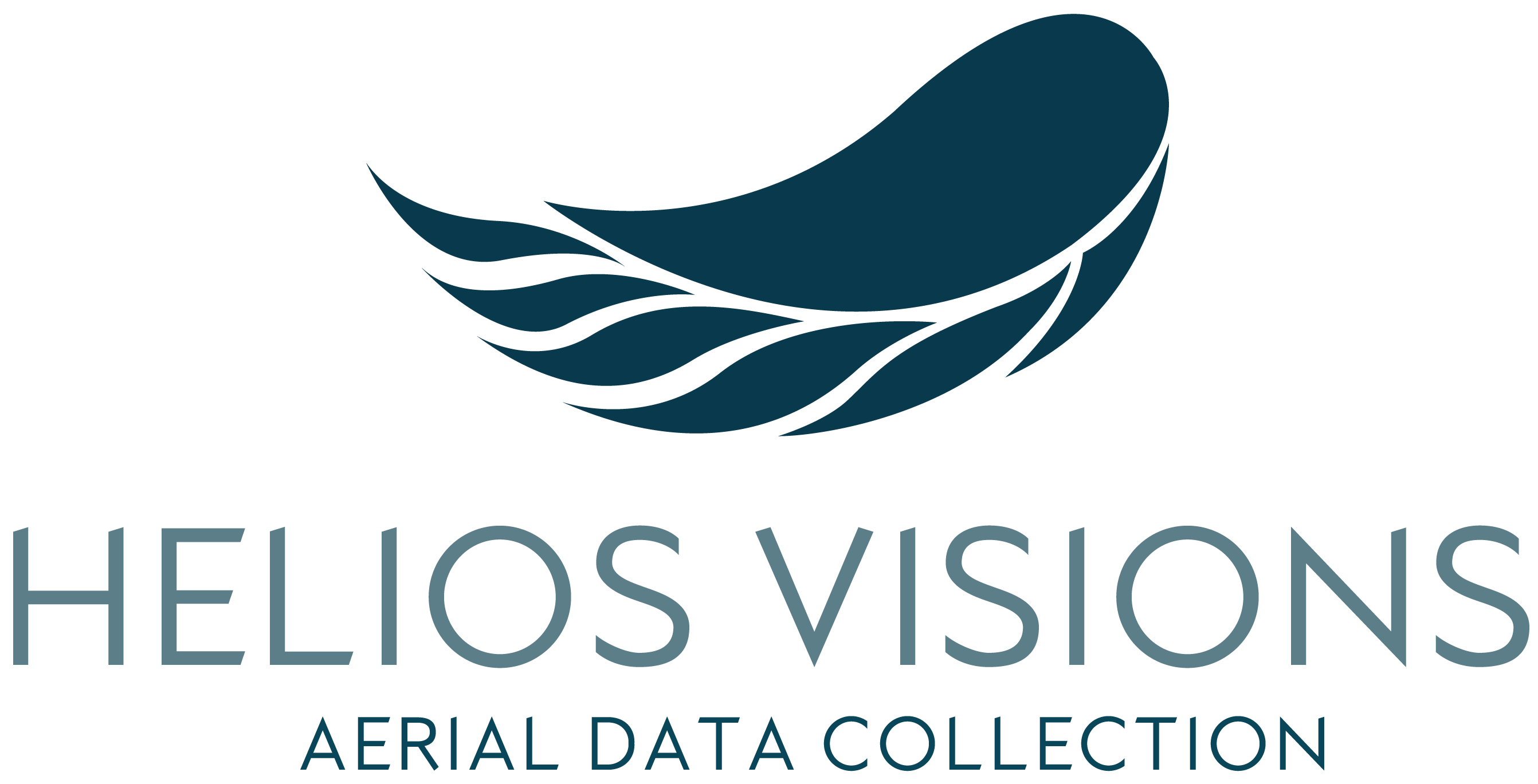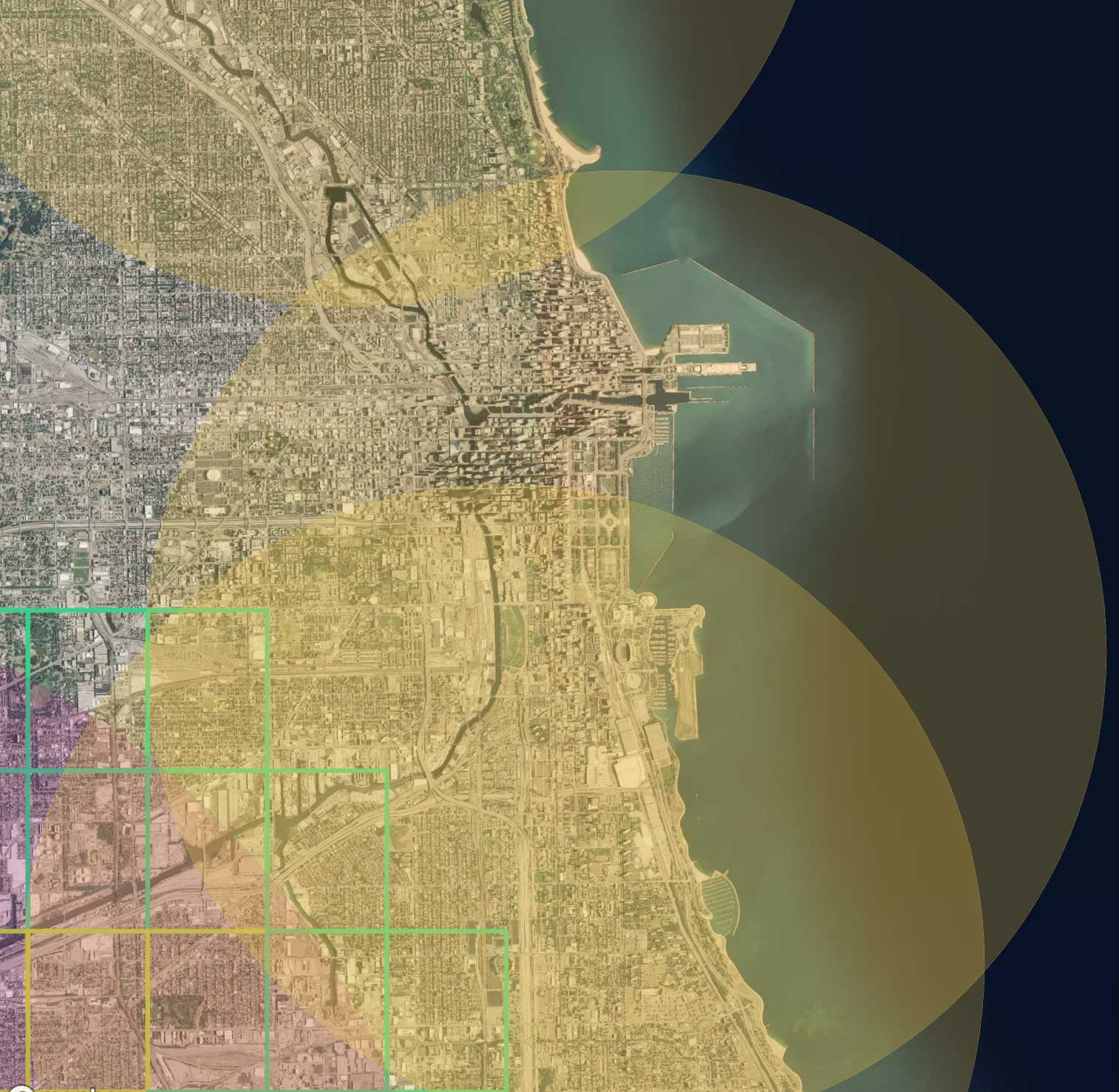We know there has been a lot of confusion in the quickly evolving rules and regulations in the drone industry.
To help clarify these rules and regulations, we created this guide to flying drones in Illinois and Chicago.
As a professional drone services company with headquarters in Chicago, we believe first and foremost in conducting safe and legal drone operations.
The safety of our staff, our clients in the AEC industry (Architecture, Engineering, and Construction), and the general public is our top priority.
We promote safe & responsible drone operations by following the FAA Guidelines and local city ordinances.
Introduction
The drone use landscape continues to change in the United States (U.S.) but for business owners, entrepreneurs, venture capitalists, hobbyists, and enthusiasts, questions still remain regarding the legality of drone/unmanned aircraft system (UAS) use and the limitations, especially in urban environments such as Chicago.
Drones have revolutionized the business world. They have given commercial and construction entities additional options for services and alternatives to traditional methods of capturing images, measurements, project progress, and so on. They have turned labor-intensive and technical tasks into automated and semi-automated flights.
Disruption observed within environments utilizing drones comes in the form of accidents, injury, negligence, airspace congestion, and even uncertainty. The governing body over drone regulations rests with the Federal Aviation Administration (FAA), the agency charged with keeping the airways safe and not fractionized.
An important item related to FAA authority is federal preemption. Federal preemption specific to aviation prevents individual states from enforcing their own legislation to restrict aircraft movement if state legislation conflicts with FAA safety priorities regarding the National Airspace System (NAS). Like most federal agencies, keeping up with changes in technology and trends tends to remain behind the private sector and local governments, and the FAA is no exception. Many states passed drone-related laws and when combined with federal regulations, the ability for a drone operator to easily navigate the legal landscape becomes muddled.
This guide serves as a summation of FAA, Illinois, and Chicago based drone laws, rules, and regulations to give you the reader a better understanding of the restrictions and allowances placed on drone operators within Illinois and Chicagoland. It is not legal advice, rather a starting point to become familiar with applicable drone restrictions.
Basic Drone Operating Requirements
The FAA just updated the requirements for recreational pilots and now “All recreational flyers must pass an aeronautical knowledge and safety test and provide proof of test passage (the TRUST completion certificate) to the FAA or law enforcement upon request.” The TRUST test is administered online and takes about 15-30 minutes to complete.
When operating a drone in Illinois, all drones weighing less than 55 pounds but more than .55 pounds must be registered through the FAA portal along with paying a $5.00 registration fee good for three years.
Applying the appropriate registration number to the exterior of the aircraft is also a requirement.
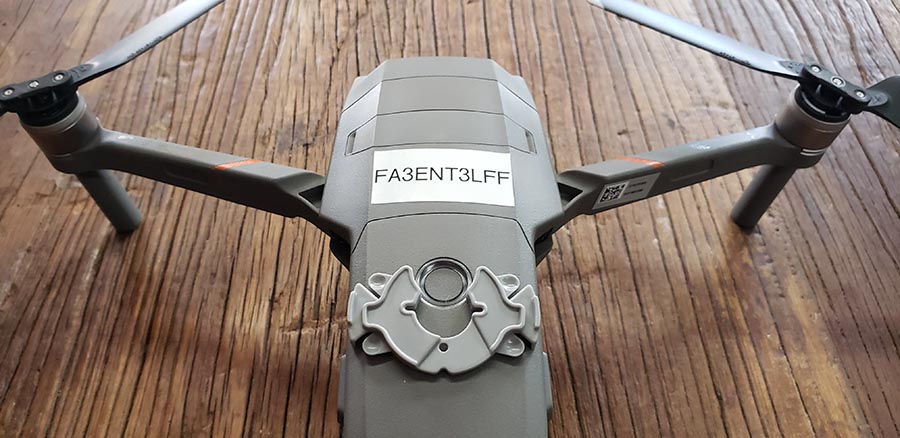
Drone Registration Number From the FAA
As a commercial operator, an FAA 14 Code of Federal Regulations (CFR) Part 107 Small UAS (sUAS) remote pilot license is required.
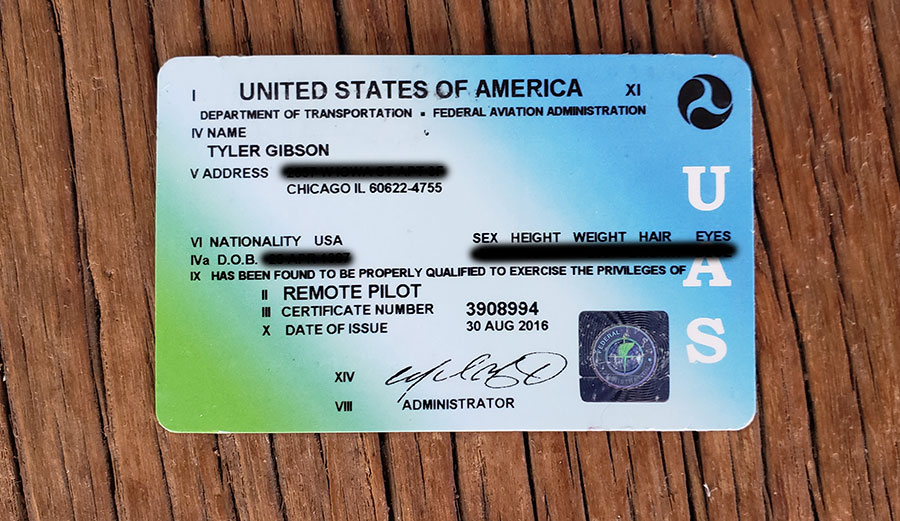
Part 107 Remote Pilot License
Applicants will have to pass the FAA Aeronautical Knowledge Test to obtain the license among other minimum eligibility requirements. Hobbyist operators simply have to follow the registration guidelines for their drone and follow community-based safety guidelines as seen within the Academy of Model Aeronautics (AMA) among other minimum FAA operating standards covered below. Lastly, if a government entity chooses to act as a public aircraft operation in Illinois, you have two options: You can operate as a commercial operator (Part 107) or via an FAA Certificate of Authorization or Waiver (COA) which can be obtained via the FAA UAS COA Online System. If you are a pilot operating under 14 CFR Part 61, you can apply to become a remote pilot via online training and after meeting other minimum requirements.
Still confused about what category applies to you?
Ask yourself if your intent is to capture data, footage, or images as part of a business or to monetize footage and images on media sharing platforms. If that is the case, you are more than likely a commercial operator. But, if you are operating a drone for leisure only and your drone operation is not intended to be associated with a business or government entity, you are more than likely a hobbyist operator.
Operating Near Airports
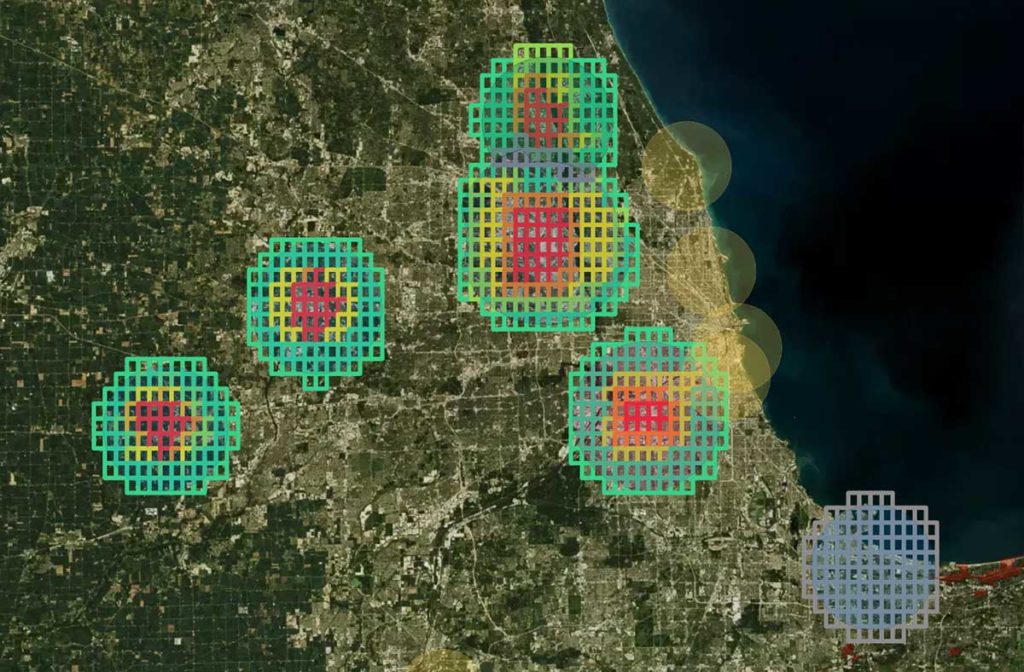
Airports in the Chicagoland Area
The FAA establishes nationwide drone operating restrictions for the public, hobbyist, and commercial operators, this guide focuses on the latter two categories. One concern raised when operating drones near airports, is determining what is permissible. Large airports can be congested with air traffic, as seen in Chicagoland.
Small regional airports and unmanned airports may have a reduction in aircraft traffic but caution should be taken regardless. Operating a drone within five miles of an airport requires additional steps. According to the FAA, these are items worth noting:
- As a licensed commercial drone operator following part 107 rules, you must get permission from air traffic control (ATC) to fly in controlled airspace. The FAA can grant permission two ways: via Low Altitude Authorization and Notification Capability (LAANC) or via DroneZone.
- If you are a recreational operator, flight in controlled airspace is limited to recreational fixed-sites that are in agreement with the FAA. Contacting ATC Towers for permission has been replaced by the fixed-site agreement pertaining to recreational drone operators. A recreational operator can use LANNC if operating under the exception for Recreational Flyers.
The Recreational Drone Operator
Hobbyist operators should adhere to the following FAA conditions found within the FAA Reauthorization Act of 2018:
- Pass the FAA TRUST aeronautical knowledge and safety test
- Fly for hobby or recreation only, at an altitude less than or equal to 400 feet in uncontrolled or “Class G” airspace
- Register your drone as noted in the basic requirements section
- Fly within visual line-of-sight (VLOS)
- Follow community-based safety guidelines as noted in the basic requirements section
- Operate a drone less than 55 pounds unless certified by a community-based organization
- Do not operate near other aircraft, especially near airports
- Never operate a drone under the influence of alcohol or drugs
- Do not operate near emergency response efforts, over people, public events, or near defined restricted areas considered critical (military bases, Department of Energy sites, etc.)
The Commercial Drone Operator
The restrictions placed on a Part 107 drone operator (commercial operator) are a bit different when compared to a hobbyist operator. Commercial operators are held to professional and safety standards and competency of FAA regulations are tested through a licensing process. The following items from the FAA must be adhered to when operating as a Part 107 pilot:
(1) Unmanned aircraft must weigh less than 55 pounds
(2) VLOS only; the unmanned aircraft must remain within VLOS of the remote pilot in command and the person manipulating the flight controls of the small UAS. Alternatively, the unmanned aircraft must remain within VLOS of the visual observer
(3) At all times the small unmanned aircraft must remain close enough to the remote pilot in command and the person manipulating the flight controls of the small UAS for those people to be capable of seeing the aircraft with vision unaided by any device other than corrective lenses.
(4) Small unmanned aircraft may not operate over any persons not directly participating in the operation, not under a covered structure, and not inside a covered stationary vehicle
(5) Daylight-only operations, or civil twilight (30 minutes before official sunrise to 30 minutes after official sunset, local time) with appropriate anti-collision lighting
(6) Must yield right of way to other aircraft
(7) May use visual observer (VO) but not required
(8) First-person view camera cannot satisfy “see-and-avoid” requirement but can be used as long as requirement is satisfied in other ways
(9) Maximum groundspeed of 100 miles per hour
(10) Maximum altitude of 400 feet above ground level (AGL) or, if higher than 400 feet AGL, remain within 400 feet of a structure
(11) Minimum weather visibility of 3 miles from control station
(12) Operations in Class B, C, D and E airspace are allowed with the required ATC permission
(13) Operations in Class G airspace are allowed without ATC permission
(14) No person may act as a remote pilot in command or VO for more than one unmanned aircraft operation at one time
(15) No operations from a moving aircraft
(16) No operations from a moving vehicle unless the operation is over a sparsely populated area
(17) No careless or reckless operations
(18) No carriage of hazardous materials
(19) Requires preflight inspection by the remote pilot in command
(20) A person may not operate a small unmanned aircraft if he or she knows or has reason to know of any physical or mental condition that would interfere with the safe operation of a small UAS
(21) Foreign-registered small unmanned aircraft are allowed to operate under part 107 if they satisfy the requirements of part 375
(22) External load operations are allowed if the object being carried by the unmanned aircraft is securely attached and does not adversely affect the flight characteristics or controllability of the aircraft. Transportation of property for compensation or hire allowed provided that the aircraft, including its attached systems, payload and cargo weigh less than 55 pounds total; The flight is conducted within VLOS and not from a moving vehicle or aircraft and the flight occurs wholly within the bounds of a State and does not involve transport between (1) Hawaii and another place in Hawaii through airspace outside Hawaii; (2) the District of Columbia and another place in the District of Columbia; or (3) a territory or possession of the United States and another place in the same territory or possession.
Although many restrictions placed on hobby operators are the same for Part 107 operators (to include the basic requirements), a major difference is Part 107 operators can apply for various waivers to meet project, mission, or commercial demands.
Drone Operation Waivers
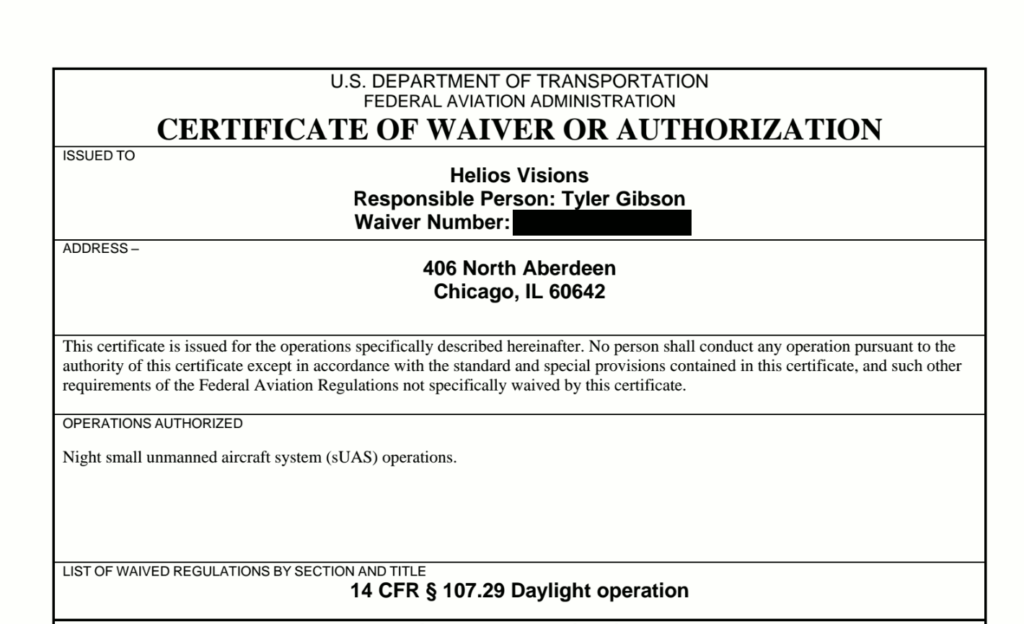
Helios Visions Daylight Waiver
As a Part 107 drone operator, there may be scenarios where you want to capture footage, images, or data that require an FAA-approved waiver. The following are the most common waivers available:
- Operating from a moving vehicle or aircraft
- Twilight and nighttime operations
- Visual line of sight aircraft operation
- Visual observer
- Operation of multiple small unmanned aircraft systems
- Yielding the right of way
- Operation over people
- Operation in certain airspace
- Operating limitations for small unmanned aircraft
Illinois Statutes and Ordinances
Illinois drone restrictions have steadily increased over the years, but as a commercial or hobbyist drone operator, there are only a handful of restrictions that apply (public use restrictions are not covered in this guide). According to Illinois legislation, an amendment to the Illinois Aeronautics Act precludes municipalities with less than 1 million residents, to enact restrictive drone ordinances. With that said, a drone operator should not interfere with a hunter or fisherman, when the hunter is legally taking wild or aquatic life. Naturally, this law does not apply to the Department of Natural Resources or United States Fish and Wildlife Service employees performing official duties, law enforcement officers in the performance of official duties, or other authorized individuals. At the time of this writing, a voyeurism statute (peeping) specific to drone use did not exist but a traditional non-drone Illinois statute does exist and disclosed it is illegal to deliberately look into a dwelling on a property through any window or other openings, that can be considered lewd or unlawful. It would be safe to assume if challenged in court, a drone operator whether hobbyist, public, or commercial found to be voyeuristically operating a drone, could be charged with voyeurism. Lastly, private property trespassing, nuisance, and privacy statutes concerning drones remain in flux throughout the country mainly because the argument stands that navigable airspace in the NAS starts at 400 feet above ground level, meaning property owners are entitled to protect airspace on their property up to 400 feet. Legal opinions vary on the topic and the discussion remains that drones operated below 400 feet can be subject to tort claims. This article does not condone acts of illegal and forceful removal of drones (also considered aircraft) from airspace over private property.
*Keep in mind, federal preemption as mentioned before. If a state drone restriction does not conflict with FAA safety priorities within the NAS, there is a possibility the state restriction is enforceable.
Chicagoland Drone Restrictions
Chicago is the only municipality in Illinois with over 1 million residents, therefore, restrictive drone ordinances that are passed not conflicting with federal law, are enforceable according to Illinois legislation.
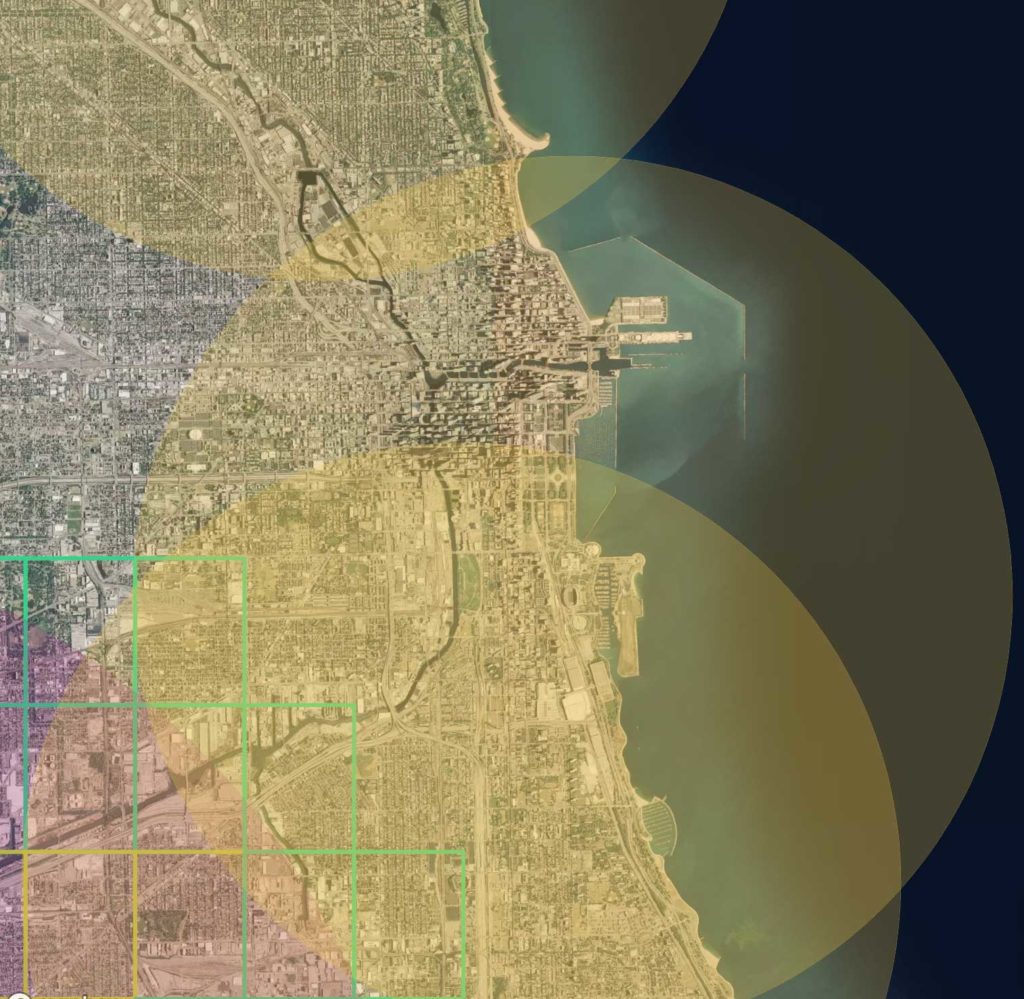
Chicago Drone Airspace
Knowing this as a drone operator is critical.
At the time this guide was written(Aug. 16, 2019), Chicago municipal code 10-36-400, Small unmanned aircraft, cited repealed Section 333 of the FAA Modernization and Reform Act of 2012, that allowed within Chicago, exception based drone operations for drones weighing more than 55 pounds.
The cited exception has been replaced by an exemption process found in Special Authority for Certain Unmanned Systems (49 U.S.C. § 44807). With that said, Chicago municipal code 10-36-400 stated drone operations were not prohibited with an approved certificate of waiver, certificate of authorization or airworthiness certificate under Section 44704 of Title 49 of the U.S.C. or other FAA grant of authority for a specific flight operation(s). Chicago municipal code 10-36-400 has elements of Part 107 (commercial operations) but overall, FAA safety regulations shall supersede conflicting state and city restrictions (federal preemption).
This means commercial operations within the bounds of Part 107 are authorized in Chicago, but Chicago drone restrictions that do not conflict with FAA established safety restrictions could be enforceable if challenged (items not covered by federal preemption).
Why is this important information for drone operators in Chicago?
Understanding how federal restrictions impact Chicago ordinances may influence a flight plan or a business endeavor, to say the least. As a rule of thumb, operating within the bounds of federal restrictions and with an abundance of caution related to Chicago ordinances should increase the likelihood of successful commercial operation or recreational flight. Chicago has several drone restrictions starting with the below items found on Chicago’s Office of the City Clerk site:
(1) No person shall operate a drone in city airspace except for hobby or recreational purposes only and in conformity with this section
(2) directly over any person who is not involved in the operation of the small unmanned aircraft, without such person’s consent
(3) over property that the operator does not own, without the property owner’s consent, and subject to any restrictions that the property owner may place on such operation
(4) at an altitude higher than 400 feet above ground level
(5) outside the visual line of sight of the operator. The operator shall use his or her own natural vision (which includes vision corrected by standard eyeglasses or contact lenses) to maintain at all times an unobstructed view of the small unmanned aircraft, without the use of vision-enhancing devices, such as binoculars, night vision goggles, powered vision magnifying devices, goggles designed to provide a “first person view” from the model or similar devices
(6) within five miles of any airport
(7) in a manner that interferes with, or fails to give way to, any manned aircraft
(8) between dusk and dawn
(9) whenever weather conditions impair the operator’s ability to operate the small unmanned aircraft safely
(10) over any open-air assembly unit, school, schoolyard, hospital, place of worship, prison or police station, without the property owner’s consent, and subject to any restrictions that the property owner may place on such operation
(11) within 500 feet of any water intake facility or any electric generating facility, sub-station or control center, or within 100 feet of any electric transmission facility, or within 25 feet of any electric distribution facility or of any overhead wire, cable, conveyor or similar equipment for the transmission of sounds or signal, or of heat, light or power, or data, upon or along any public way within the city, without the facility or equipment owner’s consent, and subject to any restrictions that the facility or equipment owner may place on such operation
(12) for the purpose of conducting surveillance, unless expressly permitted by law
(13) while under the influence of alcohol, or other drug or drugs, intoxicating compound or compounds or any combination thereof, as those terms are defined in 625 ILCS 5/11-501, as amended
(14) that is equipped with a firearm or other weapon
(15) with intent to use such small unmaimed aircraft or anything attached to it to cause harm to persons or property
(16) in a reckless or careless manner
(17) in violation of any Federal or State law
The views and opinions presented in this guide do not represent the FAA.
Still, want to learn more? Contact us today!
